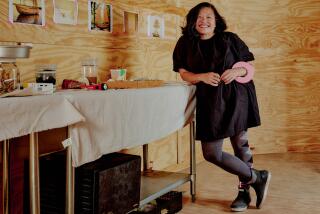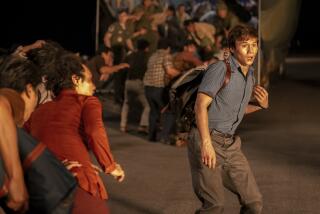Cambodian Survivor Sows Seeds of Peace : ‘ “Killing Fields” is still going on around the clock, especially in the Third World.’
- Share via
“I am not a hero or a politician, I am just one of the witnesses of the Cambodian war,” Dith Pran told 350 people who filled a UC Irvine lecture hall Wednesday night to hear his tale of survival under the brutal Communist Khmer Rouge regime.
The 1984 film “The Killing Fields” was based on Dith Pran’s experiences in forced labor camps in his homeland after Khmer Rouge forces led by Pol Pot overthrew the United States-backed Lon Nol government in April, 1975. A central element in the film is the friendship between the Cambodian photographer and a New York Times reporter, Sydney H. Schanberg. Dith Pran saved Schanberg’s life on the day the capital city of Phnom Penh fell to the Khmer Rouge, but the two were soon separated, and Schanberg returned to the United States.
Although “The Killing Fields” was based on his experiences, Dith Pran emphasized that the movie “is not just my story, it’s the story of the whole Cambodian people who survived.”
It has been seven years since Dith Pran escaped Cambodia--now the People’s Republic of Kampuchea--by walking to freedom in Thailand six months after Vietnamese forces conquered his country. He cabled Schanberg news of his survival and safety, and Schanberg helped him reach the United States. Since May, 1980, Dith Pran has been a staff photographer at the New York Times.
Yet although the Cambodian is thousands of miles from his birthplace, he has clearly not left the “killing fields” behind. From the moment he stepped off a plane at John Wayne Airport at 6 p.m. Wednesday until he boarded an 11:15 p.m. flight at Los Angeles International Airport the same night, he talked almost non-stop about Cambodia’s problems.
“I hope you understand that ‘The Killing Fields’ is not just another war movie,” he told his UCI audience in heavily accented English. “ ‘The Killing Fields’ does not really end in two hours and 15 minutes. ‘The Killing Fields’ is still going on around the clock around the world, especially in the Third World countries.”
The film did not depict the full brutality of life under the Khmer Rouge, Dith Pran said. Those who made the movie tried “to minimize all the violence because they understand the Westerner could not watch a movie that shows all the blood and killing,” he said. The Khmer Rouge killed more than 2 million Cambodians while they were in power, he said.
He survived by lying about his occupation and “playing stupid. . . . I told them I was a taxi driver. . . .” The people who told them the truth about being professional workers were killed, he said.
Forced to work long, grueling hours in rice fields while he slowly starved, Dith Pran later was given a houseboy job, then worked as a cook and a fisherman, jobs that enabled him to steal food and survive.
“For four years while I was there, you have to believe (my) life was protected by the Buddha. I’m not religious but I believe strongly that each person has his own fate, his own destiny,” Dith Pran said.
“I was lucky. . . . I still don’t believe, myself, that I survived that regime.”
Cambodia is currently occupied by Vietnamese troops, who invaded the country in 1979 and established a proxy government. The Vietnamese “liberated” Cambodia from the Khmer Rouge, but Dith Pran said he didn’t believe they would stay. “Now they seem to have become the enemy of the Cambodian people,” he said.
His people are “trapped in the middle, between the crocodile and the lion,” he added. “We don’t want the Khmer Rouge or the Vietnamese.”
Asked by an audience member if he sees parallels between the situations today in Cambodia and Nicaragua, Dith Pran smiled wryly. “Well, I’ve never been to Nicaragua,” he said, “but I will say I believe that Cambodia, Nicaragua, Afghanistan is a universal story,” that of Communists infiltrating a country and assuming power. His experiences in Cambodia have made Dith Pran anti-Communist, but he said he doesn’t want to see more fighting in his homeland.
“If we have a chance to negotiate, I think we better negotiate rather than start killing each other,” he said. He wants to see peace talks started for his country’s sake, he added.
Dith Pran was brought to UCI as part of the university’s arts and lecture series. Santi Smithsuvan, the chairman of the university’s Asian Pacific Student Staff Assn., said his visit was appropriate because the school’s Asian population is larger than that at any other university on the continental United States. However, Smithsuvan added, very few of UCI’s students are Cambodians.
Sary Seng, a freshman physics major, is one of those few Cambodian students. Sary Seng was 8 when the Khmer Rouge took over her country, and she remembers being separated from her family and sent to work in the fields with other children her age.
Her mother, who was pregnant at the time of the takeover, later died. Her father, whom she hasn’t seen since 1975, is still in Cambodia. A sister “was sent away and never returned,” she said, but Sary Seng and her other sister and three brothers made it to the United States with an aunt in 1980.
After the takeover, the Khmer Rouge taught the children that “the only thing we should respect is the boss; our parent is nothing,” Sary Seng said. The children’s field work began early each morning and lasted until sunset, she said. They slept on the ground, were given little food when they worked and none when they were sick, and were treated brutally.
She has seen “The Killing Fields” twice. The film, she said, only showed “a portion of what I experienced.” But listening to Dith Pran brought back many memories of her homeland.
After the lecture, Dith Pran left immediately for the airport. Traveling north in a van filled with UCI students, the short, wiry man still radiated energy despite a long day that began with a speech in Wichita, Kan. He went on answering questions and talking earnestly about Cambodia’s problems and he encouraged the students to express their own opinions. He also accepted materials about the Orange County-based Project Deliverance, which works to help Vietnamese at a refugee camp in Thailand.
When asked if he would like to return to Cambodia someday, he replied:
“I was invited by the puppet government and the Vietnamese government to go back, and I don’t want to . . . talk with the politicians as long as they continue fighting. If I go back, I want to meet the people, not the politicians.”
But if peace came to Cambodia, he added, he would like to help arrange for medical care and other aid for his countrymen.
Traveling back to Orange County after Dith Pran boarded his plane, My-Nga Le, the president of UCI’s Vietnamese Student Assn., said she had been energized by meeting the Cambodian but “what he had to tell wasn’t new to me.”
Le left Vietnam in 1975, when she was 8 and has vivid memories of the evacuation. “I wasn’t aware of what was going on (politically), except through the reactions of my parents,” she said. Now, Le said, she wants to help other Vietnamese.
Meeting Dith Pran gave her “a clearer idea of what needs to be done.” But while Dith Pran spoke of the need to make Westerners aware of Southeast Asians’ suffering under Communist regimes, Le said she wants to “make the (Orange County) Vietnamese community aware” of ways they can help each other.
The student association she heads raises funds to help Vietnamese refugees reach safety, but eventually she wants to do more for Vietnamese both here and overseas. “I’m only a college student--but I’m thinking about what I can do after I finish college,” she said.
Last February, Dith Pran, now 44, became a U.S. citizen. He lives in Brooklyn with his wife and four children. His youngest son, who was 2 1/2 when he left Cambodia, has trouble believing his father’s stories about what life was like under the Khmer Rouge.
Like any refugee, Dith Pran said, he had trouble adjusting to his new lifestyle when he arrived in the United States, but his past experiences working with Westerners--as a hotel manager, and then as a translator and journalist working with foreign correspondents--made it less difficult.
Beside traveling around the country to talk about Cambodia, Dith Pran is also working on a book about his experiences. He said he and Schanberg no longer see each other very much.
But the bond between him and Schanberg is still strong.
“Even when I was trapped by the Khmer for four years, Sydney was still thinking and dreaming about me. . . . We become like one person. . . . He used to be my boss, my friend, and now he’s my brother. We love each other.”
More to Read
Sign up for Essential California
The most important California stories and recommendations in your inbox every morning.
You may occasionally receive promotional content from the Los Angeles Times.










